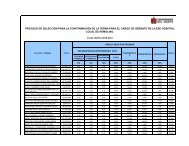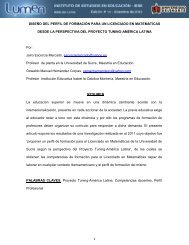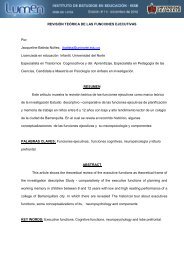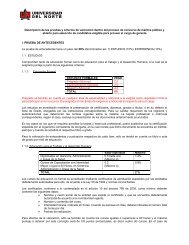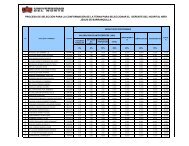Determinantes de la informalidad laboral y el subempleo en las ...
Determinantes de la informalidad laboral y el subempleo en las ...
Determinantes de la informalidad laboral y el subempleo en las ...
Create successful ePaper yourself
Turn your PDF publications into a flip-book with our unique Google optimized e-Paper software.
Abstract<br />
Colombia as w<strong>el</strong>l as most Latin American countries, shows a marked heterog<strong>en</strong>eity in its <strong>la</strong>bor<br />
markets, in such a way that it possible to see together sectors whose employees have a wi<strong>de</strong> range<br />
of non-wage b<strong>en</strong>efits provi<strong>de</strong>d by the state and sectors in which their employees do not <strong>en</strong>joy the<br />
assistance of the State in regard to non-wage b<strong>en</strong>efits such as social security, for example. H<strong>en</strong>ce,<br />
in rec<strong>en</strong>t years, the study of working conditions and job quality has become important, precis<strong>el</strong>y<br />
because of its r<strong>el</strong>evance to public and private policy. Because of this, informality and un<strong>de</strong>remploym<strong>en</strong>t<br />
<strong>de</strong>serve special importance as variables that measure the low quality of employm<strong>en</strong>t:<br />
the first from the viewpoint of <strong>la</strong>bor <strong>de</strong>mand and the second from the point of view of supply.<br />
This docum<strong>en</strong>t is a <strong>de</strong>scriptive analysis of <strong>la</strong>bor market of the three metropolitan areas in the Caribbean<br />
region and the dim<strong>en</strong>sions of informality and un<strong>de</strong>remploym<strong>en</strong>t. Subsequ<strong>en</strong>tly, we estimate<br />
a bivariate probit mo<strong>de</strong>l to estimate the impact of socioeconomic <strong>de</strong>terminants of informal<br />
employm<strong>en</strong>t and un<strong>de</strong>remploym<strong>en</strong>t on the probability of being an employee of low quality in<br />
the three metropolitan areas m<strong>en</strong>tioned above. The results show that years of education, g<strong>en</strong><strong>de</strong>r,<br />
head of household, marital status, employm<strong>en</strong>t rearrangem<strong>en</strong>t time and age, influ<strong>en</strong>ce the lik<strong>el</strong>ihood<br />
of being an employee of low quality.<br />
IEEC 32.indd 8<br />
19/01/2011 04:39:27 p.m.



